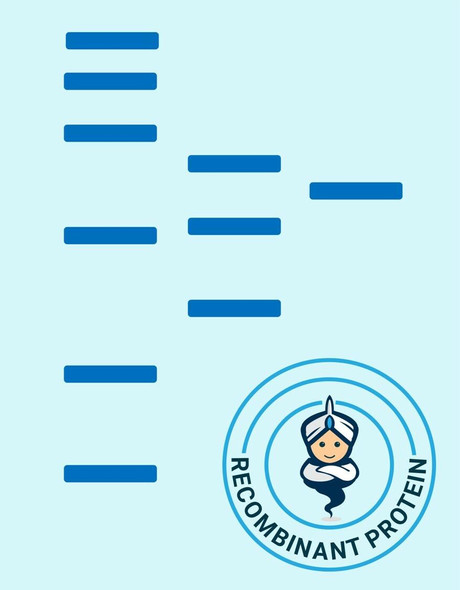Description
| Product Name: | Human PEX19 Recombinant Protein |
| Product Code: | RPPB4226 |
| Size: | 20µg |
| Species: | Human |
| Target: | PEX19 |
| Synonyms: | Peroxisomal biogenesis factor 19, Peroxisomal farnesylated protein, HK33, 33kDa housekeeping protein, PXF, PMP1, PXMP1, Peroxin-19, D1S2223E, FLJ55296. |
| Source: | Escherichia Coli |
| Physical Appearance: | Sterile Filtered colorless solution. |
| Formulation: | The PEX19 solution (1mg/ml) contains 20mM Tris-HCl buffer (pH 8.0) and 10% glycerol. |
| Stability: | Store at 4°C if entire vial will be used within 2-4 weeks. Store, frozen at -20°C for longer periods of time. For long term storage it is recommended to add a carrier protein (0.1% HSA or BSA).Avoid multiple freeze-thaw cycles. |
| Purity: | Greater than 90% as determined by SDS-PAGE. |
| Amino Acid Sequence: | MGSSHHHHHH SSGLVPRGSH MAAAEEGCSV GAEADRELEE LLESALDDFD KAKPSPAPPS TTTAPDASGP QKRSPGDTAK DALFASQEKF FQELFDSELA SQATAEFEKA MKELAEEEPH LVEQFQKLSE AAGRVGSDMT SQQEFTSCLK ETLSGLAKNA TDLQNSSMSE EELTKAMEGL GMDEGDGEGN ILPIMQSIMQ NLLSKDVLYP SLKEITEKYP EWLQSHRESL PPEQFEKYQE QHSVMCKICE QFEAETPTDS ETTQKARFEM VLDLMQQLQD LGHPPKELAG EMPPGLNFDL DALNLSGPPG ASGEQC |
PEX19 is vital for peroxisome biogenesis in Saccharomyces cerevisiae. PEX19 is limited to the outer surface of peroxisomes in liver cells and is has a part in the early stage of peroxisome membrane assembly, prior to the import of matrix protein.
PEX19 Human Recombinant produced in E.coli is a single, non-glycosylated polypeptide chain containing 316 amino acids (1-296) and having a molecular mass of 34.6 kDa.The PEX19 is fused to a 20 amino acid His-Tag at N-terminus and purified by proprietary chromatographic techniques.
| UniProt Protein Function: | PEX19: Necessary for early peroxisomal biogenesis. Acts both as a cytosolic chaperone and as an import receptor for peroxisomal membrane proteins (PMPs). Binds and stabilizes newly synthesized PMPs in the cytoplasm by interacting with their hydrophobic membrane-spanning domains, and targets them to the peroxisome membrane by binding to the integral membrane protein PEX3. Excludes CDKN2A from the nucleus and prevents its interaction with MDM2, which results in active degradation of TP53. Defects in PEX19 are the cause of peroxisome biogenesis disorder complementation group 14 (PBD-CG14); also known as PBD-CGJ. PBD refers to a group of peroxisomal disorders arising from a failure of protein import into the peroxisomal membrane or matrix. The PBD group is comprised of four disorders: Zellweger syndrome (ZWS), neonatal adrenoleukodystrophy (NALD), infantile Refsum disease (IRD), and classical rhizomelic chondrodysplasia punctata (RCDP). ZWS, NALD and IRD are distinct from RCDP and constitute a clinical continuum of overlapping phenotypes known as the Zellweger spectrum. The PBD group is genetically heterogeneous with at least 14 distinct genetic groups as concluded from complementation studies. Defects in PEX19 are a cause of Zellweger syndrome (ZWS). ZWS is a fatal peroxisome biogenesis disorder characterized by dysmorphic facial features, hepatomegaly, ocular abnormalities, renal cysts, hearing impairment, profound psychomotor retardation, severe hypotonia and neonatal seizures. Death occurs within the first year of life. Belongs to the peroxin-19 family. 5 isoforms of the human protein are produced by alternative splicing. |
| UniProt Protein Details: | Protein type:Membrane protein, integral; Chaperone Chromosomal Location of Human Ortholog: 1q23.2 Cellular Component: brush border membrane; cytoplasm; cytosol; integral to membrane; intracellular membrane-bound organelle; nucleoplasm; nucleus; peroxisomal membrane; peroxisome; protein complex Molecular Function:ATPase binding; protein binding; protein N-terminus binding Biological Process: peroxisome fission; peroxisome membrane biogenesis; peroxisome organization and biogenesis; protein import into peroxisome membrane; protein stabilization; protein targeting to peroxisome; transmembrane transport Disease: Peroxisome Biogenesis Disorder 12a (zellweger) |
| NCBI Summary: | This gene is necessary for early peroxisomal biogenesis. It acts both as a cytosolic chaperone and as an import receptor for peroxisomal membrane proteins (PMPs). Peroxins (PEXs) are proteins that are essential for the assembly of functional peroxisomes. The peroxisome biogenesis disorders (PBDs) are a group of genetically heterogeneous autosomal recessive, lethal diseases characterized by multiple defects in peroxisome function. These disorders have at least 14 complementation groups, with more than one phenotype being observed for some complementation groups. Although the clinical features of PBD patients vary, cells from all PBD patients exhibit a defect in the import of one or more classes of peroxisomal matrix proteins into the organelle. Defects in this gene are a cause of Zellweger syndrome (ZWS), as well as peroxisome biogenesis disorder complementation group 14 (PBD-CG14), which is also known as PBD-CGJ. Alternative splicing results in multiple transcript variants. [provided by RefSeq, Aug 2010] |
| UniProt Code: | P40855 |
| NCBI GenInfo Identifier: | 729723 |
| NCBI Gene ID: | 5824 |
| NCBI Accession: | P40855.1 |
| UniProt Secondary Accession: | P40855,Q5QNY4, Q8NI97, D3DVE7, |
| UniProt Related Accession: | P40855 |
| Molecular Weight: | � Da |
| NCBI Full Name: | Peroxisomal biogenesis factor 19 |
| NCBI Synonym Full Names: | peroxisomal biogenesis factor 19 |
| NCBI Official Symbol: | PEX19�� |
| NCBI Official Synonym Symbols: | PXF; HK33; PMP1; PMPI; PXMP1; PBD12A; D1S2223E�� |
| NCBI Protein Information: | peroxisomal biogenesis factor 19 |
| UniProt Protein Name: | Peroxisomal biogenesis factor 19 |
| UniProt Synonym Protein Names: | 33 kDa housekeeping protein; Peroxin-19; Peroxisomal farnesylated protein |
| Protein Family: | Peroxisomal biogenesis factor |
| UniProt Gene Name: | PEX19�� |
| UniProt Entry Name: | PEX19_HUMAN |






